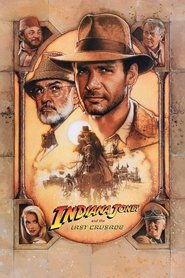... and then they rode into the sunset and finished a perfect trilogy, and were never tempted to make a fourth instalment for obscure reasons. Unrelated, but did you know this had script rewrites from Tom Stoppard?
Although Last Crusade suffers for the lack of a really memorable central villain (notwithstanding Hitler’s cameo during a scene set at a book-burning rally)[,] what feels new—and fun—is the sense of Indy meeting his match in the form of his father, which has as much to do with Connery’s roughly equivalent star power and 007 associations as anything his character says or does. […] What comes through most strongly in The Last Crusade—and what makes it, finally, the sweetest of the films—is its embedded sense of reassurance, visualized by Spielberg as a literal ride into the sunset. I’ve always felt that this final shot was also the end of analogue action movies as we know them. In the summer of 1989, James Cameron was already gazing into the CGI mirror of The Abyss, and within the next five years, an onslaught of artificial-yet-authentic T-1000s and T. Rexes would rewire the Hollywood blockbuster into something more ruthlessly technocratic.
— Adam Nayman (The Ringer)
The great trick of this film is the way in which it depicts Indy as a typically flawed everyman American hero—humble, instinctive, but capable of mistake and miscalculation—only then to elevate and remystify him. Unlike Bond, Indy is prone to severe blunders: entrusting the map that leads to the location of the Grail to his inept fellow teacher Marcus Brody (Denholm Elliott): assuming that Elsa’s (Alison Doody) room has indeed been ransacked by an intruder rather than by the cunning Nazi herself; discounting the self-incriminating warning from the man who bankrolls the Grail expedition, Walter Donovan (Julian Glover), to “not trust anybody.” Time and again, Indy makes the wrong decision, right down to nearly delivering his father’s Grail diary right into the hands of Hitler, in the movie’s most ostentatious and cartoonish moment. Yet Indy is always also figured as the American knight. While fleeing the castle Brunwald with his father, he quite literally engages in a motorcycle joust, spearing Nazis with a roadblock he grabs opportunistically.[…]
Should it give us pause, though, that this decidedly Christian story, which reaffirms the fundamental truth of the Jesus narrative, was “authored” by a Jewish director? […] Indy’s leap of faith could be taken as an affirmation of Christian theology, but the camera movement that immediately follows shifts the focus of the scene. With that crane, Spielberg changes the emphasis from Indy’s sense of wonder to our own, from the supernatural to the special effect.
— Chris Wisniewski (Reverse Shot)
It doesn’t require explicitly siding with historical villainy to [recognize] ideological transmission at work: the implication that, while it is not okay for all white people to pillage valuable artifacts from Middle Eastern regions, it is acceptable, even desirable, for some to do so. The images and ideas contained within the Indiana Jones films are certainly deeply indebted to a different religious tradition—cinema, from B-movies to Westerns—as opposed to a mystical or religious one, but it is curious that in two of the four films to date, the sought objects in question are Judeo-Christian in origin.
— Jeff Reichert (Reverse Shot)
Synopsis: In 1938, an art collector appeals to eminent archaeologist Dr. Indiana Jones to embark on a search for the Holy Grail. Indy learns that a medieval historian has vanished while searching for it, and the missing man is his own father, Dr. Henry Jones Sr.. He sets out to rescue his father by following clues in the old man's notebook, which his father had mailed to him before he went missing. Indy arrives in Venice, where he enlists the help of a beautiful academic, Dr. Elsa Schneider, along with Marcus Brody and Sallah. Together they must stop the Nazis from recovering the power of eternal life and taking over the world!

